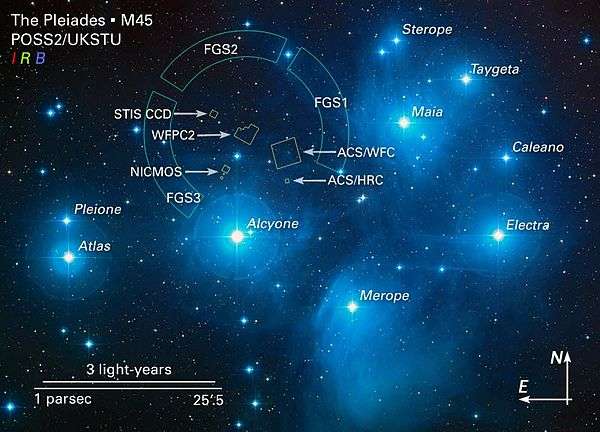Atlas (star)
 Atlas is found on the left section of the map. | |
| Observation data Epoch J2000 Equinox J2000 | |
|---|---|
| Constellation | Pleiades |
| Right ascension | 03h 49m 09.7s |
| Declination | +24° 03′ 12″ |
| Apparent magnitude (V) | 3.62 |
| Characteristics | |
| Spectral type | B8 III |
| U−B color index | -0.36 |
| B−V color index | -0.09 |
| Variable type | Suspected |
| Astrometry | |
| Radial velocity (Rv) | +8.5 km/s |
| Proper motion (μ) | RA: 17.77 mas/yr Dec.: -44.7 mas/yr |
| Parallax (π) | 8.57 ± 1.03 mas |
| Distance | 435 ly (128 pc) |
| Absolute magnitude (MV) | -2.04 |
| Other designations | |
Atlas, also designated 27 Tauri, is a triple star system in the constellation of Taurus and a member of the Pleiades open star cluster (M45).
Nomenclature
27 Tauri is the star's Flamsteed designation.
Atlas was the Titan god of endurance and astronomy[1] and the father of the Pleiades sisters in Greek mythology.
In 2016, the International Astronomical Union organized a Working Group on Star Names (WGSN)[2] to catalogue and standardize proper names for stars. The WGSN approved the name Atlas for this star on 21 August 2016 and it is now so entered in the IAU Catalog of Star Names.[3]
Properties
The primary component, Atlas A, is a blue-white B-type giant with an apparent magnitude of +3.62. It is a spectroscopic binary whose components have magnitudes of +4.1 and +5.6. The binary makes one orbit every 1250 days. Atlas A also has a dimmer magnitude +6.8 companion, Atlas B, at a separation of 0.4 arcseconds or at least 52 astronomical units away.
References
- ↑ Stenner, Paul (auth.); Martin, Jack. Slaney, Kathleen L. Sugarman, Jeff. (edit.) The Wiley Handbook of Theoretical and Philosophical Psychology: Methods, Approaches, and New Directions for Social Sciences. John Wiley & Sons, 2015; pg. 311.
- ↑ IAU Working Group on Star Names (WGSN), International Astronomical Union, retrieved 22 May 2016.
- ↑ "IAU Catalog of Star Names". Retrieved 28 July 2016.
External links
| Wikimedia Commons has media related to Atlas (star). |